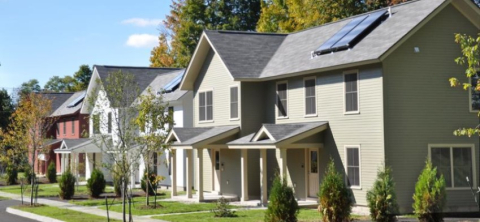More than one in three Vermont households live in homes that consume unsustainably high portions of their income, according to estimates from the U.S. Census Bureau. A new report from the Urban Institute proposes solutions to grow and preserve the nation’s affordable housing stock, some of which are already being implemented across Vermont.

The affordable housing crisis that our country faces was precipitated by insufficient construction of new homes over the last several decades, according to the report. It encourages communities to revise overly restrictive zoning regulations so that developers can produce more housing at a lower cost. To that end, VHFA has joined the Thriving Communities campaign, a Vermont initiative to provide business leaders, public officials, local and regional planners, and developers with the tools to promote affordable housing in their communities. VHFA also offers tools for communities on its Vermont Housing Data website and directly supports the construction of new homes by awarding tax credits and loans for affordable housing.
The report also highlights the importance of preserving existing affordable homes, particularly those that are not subsidized and are at risk of rising rents or displacement by new development. A major roadblock to preserving the supply of naturally occurring affordable housing is a lack of records indicating where this stock is located. The State of Vermont’s Rental Housing Advisory Board has recommended considering a rental registry to help address health and safety violations. Access to this information would help Vermont towns identify the rental housing within their boundaries, which would allow them act proactively to protect it.
To improve affordability of the existing housing stock, the Urban Institute calls for a substantial expansion of housing assistance for low-income renters. In Vermont, most low-income households do not live in subsidized apartments or receive vouchers and must pay market rates. The median rent is unaffordable to minimum wage workers in every Vermont county. The report suggests initiatives including tax credits for renters and supplements to the earned income tax credit to reflect local housing costs.
Finally, the report calls on communities to expand access to homeownership, which not only supports households’ economic security and well-being, but also helps families build long-term wealth. Homeownership has been difficult to achieve for many groups in the wake of the Great Recession, especially Millennials and people of color. The homeownership rate for Black Vermonters is just 22 percent, compared to 71 percent of White households. The Urban Institute recommends developing novel methods for homeownership that can open the door to those previously shut out. The report highlights Champlain Housing Trust’s shared equity homeownership model as a model for allowing low-income households to buy homes without excessive debt, while keeping the unit permanently affordable. The report also argues for more inclusive lending practices that lower the barriers for first-time homebuyers with limited incomes or imperfect credit histories. VHFA’s homeownership programs offer down payment assistance to eligible low and moderate income households, helping them purchase their first home with less financial strain.
For all of these initiatives, the Urban Institute emphasizes the importance of access to strong research and data so that housing advocates can effectively argue their case to their communities. VHFA operates HousingData.org, which includes a directory of subsidized rental housing in Vermont, a toolbox of housing policy resources, and community profiles with housing-related data at the state, county, and local level.
Pictured: Roaring Branch Apartments in Bennington
